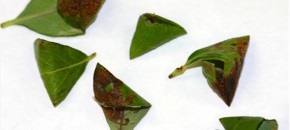Potato Disease Forecasting Report 8-2-13 – Click to Download We will be tracking DSVs for Late blight development and calculating P-days for initiating the first early blight fungicide application. The first late blight fungicide application is recommended once 18 DSVs accumulate from green row. Green row typically occurs around the first week in May in southern […]
Continue reading...Fruit IPM Report: Week Ending 8/3/13
Fruit IPM Report 8-3-13 – Click to View | Download | Print In this report: Brown Marmorated Stink Bug Peach Apple Grape Scouting Calendar Blueberry Trap Counts
Continue reading...Blueberry Pest in Detail: Leafminers

The blueberry leafminer is generally not considered an economic pest problem mainly because larvae experience high levels of parasitism in most blueberry fields. Larval parasitism can reach levels up to 80%. Use of broad-spectrum insecticides can have a severe effect on the natural enemy populations of the leafminer. Because of potential contamination, the blueberry leafminer […]
Continue reading...Veg IPM Update: Week Ending 7/31/13
Vegetable IPM Report 7-31-13 – Click to View | Download | Print Current Week’s Pest Maps – Available Maps for the week are highlighted European Corn Borer Map Corn Earworm Blacklight Map Corn Earworm Pheromone Map Brown Marmorated Stinkbug Map Vegetable IPM Pest Map Archive
Continue reading...Potato Disease Forecasting Report 7-30-13
Potato Disease Forecasting Report 7-30-13 – Click to Download We will be tracking DSVs for Late blight development and calculating P-days for initiating the first early blight fungicide application. The first late blight fungicide application is recommended once 18 DSVs accumulate from green row. Green row typically occurs around the first week in May in southern […]
Continue reading...Tomato Disease Forecasting Report 7-30-13
7-30-13 Tomato Report – Click to Download Disease severity values (DSVs) for early blight, septoria leaf spot, and tomato anthracnose development are determined daily based on leaf wetness (due to rainfall, dew) and air temperature. On a daily basis DSV values can range from 0 to 4 where 0 = no chance for disease development […]
Continue reading...